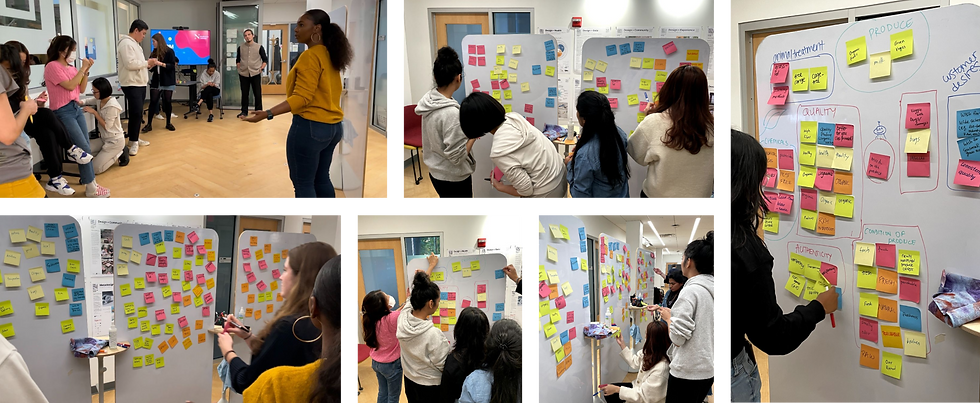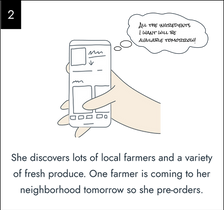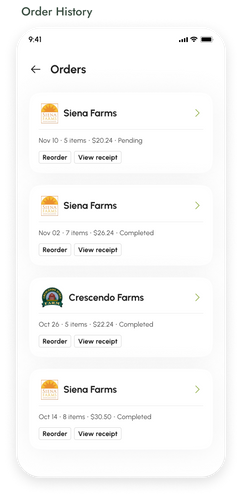Jane Effanga
Design Strategist

FARM TO YOU
Balancing convenience & authenticity.
Farmers' markets are community cornerstones, connecting small-scale farmers with consumers who value fresh, locally-sourced produce and sustainable agriculture. As consumer behavior shifts toward on-demand convenience, these markets face pressure to adapt while preserving their authenticity. Farm To You explores how to bridge this gap.
AFFILIATION
College of Arts, Media & Design, Northeastern University
PROJECT TEAM
Jane Effanga
Yixuan Zhong
YEAR
FALL 2022
THE CHALLENGE
Bridging convenience and authenticity in local food access.
Farmers' markets thrive on direct interaction, community connection, and the authentic experience of buying fresh produce directly from farmers. However, as consumer expectations shift toward on-demand convenience, tension emerges: the traditional model requires in-person visits at specific times and locations, while consumers increasingly expect food to come to them. How might we adapt the farmers' market experience to meet these changing expectations while preserving the transparency, trust, and farmer-consumer relationships that make farmers' markets valuable?



RESEARCH & DISCOVERY
Understanding the ecosystem
To ground our work in reality, we first had to understand the complex network of actors involved in a farmers' market. We conducted field research at local markets, holding informal interviews with both farmers and consumers to understand their goals, needs, and pain points.
Key Research Findings
Consumers...
Value the freshness and quality of local produce and the authentic experience of buying from a farmer, but also seek convenience.
Farmers...
Prioritize direct connections with consumers but struggle to compete with larger producers and lack resources for home delivery.

OPPORTUNITY
Leverage existing farmer routines to deliver convenience without losing community.
Research revealed a clear tension: consumers want convenience, but not at the cost of losing what makes farmers' markets special—the direct interaction, transparency, and sense of community.
From our conversations with farmers, we discovered they already travel consistent routes to markets multiple times per week, passing through residential neighborhoods along the way. We could design a service that leveraged these existing routines while preserving the authentic farmer-consumer connections that define the farmers' market experience.
The essence of the farmers' market isn't the place—it's the exchange: the interaction, trust, and transparency between people and their food.
SOLUTION
An "ice cream" truck for local produce.
Inspired by the ice cream truck model, Farm To You enables farmers to leverage their existing travel routes to make scheduled stops in neighborhoods for easy pickup and purchase. The service preserves direct farmer-consumer interaction while delivering the convenience modern consumers expect.
Storyboard

Melody is a busy foodie passionate about locally sourced produce. She loves trying new recipes and prefers buying directly from farmers at the farmer's market but her hectic schedule makes frequent visits challenging.
SERVICE DESIGN
Translating insights into a working service model.
Defining how the service would work involved creating personas, mapping user journeys, conducting role-playing exercises, and developing a service blueprint. These exercises helped identify functional requirements, surface pain points, and refine the core features of the service.
Service Blueprint

Features
The following are key functional requirements identified for both consumers and farmers.
Consumers should be able to...
-
Receive route announcement notifications
-
View farm profiles and catalogs
-
Subscribe/unsubscribe to farms
-
Create/update their account details
-
Pre-order products
-
Create a shopping list
-
Track the status of the truck in real-time
-
Set alerts for when the truck is within a certain radius or time frame
-
Provide feedback on delivery service and status
-
Chat with the farmer
Farmers should be able to...
-
Set up farm profile - catalogue, outlets, commute days and times
-
Check in and make trip announcements
-
Post and update product quantity and price
-
Track the truck in real time
-
Receive notifications for interested customers
-
Track progress - completed trips, remaining trips and ETA
-
Track inventory
-
Receive payments
-
Opt in/out
-
Provide feedback
EXPERIMENTATION
Key Design Decisions and Mockups
Community Features
Insight: Consumers value community engagement and transparency.
We added features for users to find neighbors, search recipes, and post updates. By connecting users with others who share their passion for supporting local agriculture, we aim to create a more engaging and rewarding experience for everyone.

Farmers' Wait Time Countdown
Insight: Efficient time management is crucial for both farmers and consumers.
To optimize the delivery process, we added a wait time countdown for farmers at each stop. This allows farmers to manage their time more effectively and avoid waiting indefinitely, while also enabling consumers to plan their visits more efficiently and avoid missing out on their desired products.

Pre-ordering Feature
Insight: Consumers want to ensure the availability of desired products, and farmers need to plan inventory.
The pre-ordering feature enables consumers to reserve items in advance, ensuring that the farmer has enough inventory to meet demand. This feature also benefits farmers by allowing them to better plan their inventory for each stop.

Unique QR code for consumers
Insight: Integrating online and offline activities can significantly enhance user convenience and operational efficiency.
Each consumer receives a unique QR code that facilitates seamless payment both online and offline, enables users to track their purchase history, integrates pre-ordering with in-person purchases, enhances security and transparency, and improves overall user experience by streamlining transactions and inventory management.

Rating System
Insight: Gathering comprehensive feedback is essential for improving service quality and managing user experiences.
Implementing a rating system that allows users to rate their delivery experience, provide feedback on uncollected orders, and track overall satisfaction to ensure quality control and manage refunds if necessary.

LEARNINGS & TAKEAWAYS
Assumptions are hypotheses, not facts. We initially assumed consumers wanted home delivery above all else. Research revealed they valued convenience, but not at the cost of losing direct farmer interaction—shifting our focus from delivery to accessible pickup.
Design as mediation. This project taught me that good design doesn't choose between competing needs—it finds ways to honor both. Farm To You balanced consumer convenience with farmer authenticity by working within existing constraints rather than against them.
Systems thinking reveals better solutions. By understanding how farmers, consumers, and logistics interact as a system, I designed a service that worked for everyone—not just a transactional interface, but a model that preserved meaningful relationships while solving practical problems.

























